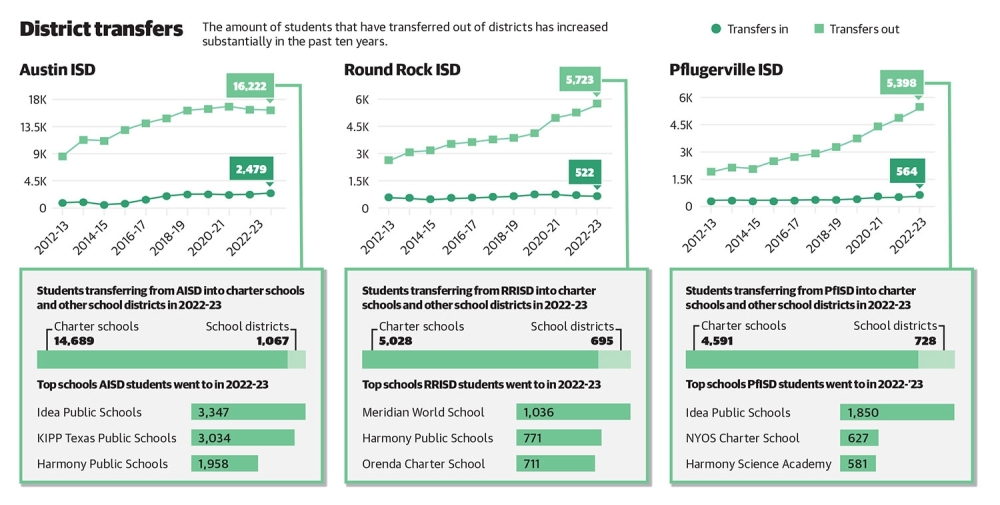School districts receive funding based on attendance, making student enrollment an important factor as districts face financial hurdles from the state and immediate communities. Simultaneously, enrollment data indicates many families feel the districts are not meeting their needs, and are seeking more satisfying options.
“Many of the urban districts in Texas are facing enrollment declines,” Austin ISD Chief Financial Officer Eduardo Ramos said. “Whether it’s because parents are homeschooling their students or students are going to charter schools.”
The overview
Community Impact analyzed Texas Education Agency, U.S. Census Bureau and withdrawal data from local school districts to find out where students are going. Overwhelmingly, data indicates families are choosing charter schools.
Transfer data from the TEA shows 90% of students that transferred out of AISD for the 2023-24 school year chose a charter school. These are public schools and receive federal funding but are subject to fewer state laws, according to the TEA.
Round Rock ISD and Pflugerville ISD lost 12.3% and 19% of students transferring out to charter schools or other public districts in the 2022-23 school year, TEA data shows.
In the last decade, four charter schools opened in North Austin suburbs: Harmony and Idea public schools, BASIS Texas Charter Schools and Valor North Austin.
New educational options are not limited to charter schools. New private schools, such as Acton Academy Northwest Austin, and homeschooling groups have also been formed.

By the numbers
AISD enrollment declined 10% from the 2017-18 to 2022-23 school years. Compared to the number of school-aged children within district boundaries, AISD captured about 66% of local students, according to U.S. Census Bureau data. The number of students transferring out of the district increased 89% between the 2012-13 and 2022-23 school years.
Despite area population increases, RRISD enrollment has declined in the last five years. RRISD served about 79% of the school-aged children within their districts in the 2022-23 school year, while the amount of students transferring out between the 2012-13 and 2022-23 school years more than doubled.
The number of students leaving PfISD grew 206% between the 2012-13 and 2022-23 school years, while enrollment has only grown by around 2,000 students in the last decade. PfISD served 65% of the school-aged children within its boundaries in the 2022-23 school year.
For the 2023-24 school year, a drop in enrollment impacted traditional Texas school districts while charter schools saw an increase in enrollment, said Bob Popinski, senior director of policy for public education advocacy group Raise Your Hand Texas.
“Over time, we have seen a drastic increase in enrollment in our charter schools, and a decrease in enrollment especially in urban areas of traditional school districts,” Popinski said.
What it means
Families consider different educational paths for a variety of reasons.
Sarah Gardner, director of community engagement for Meridian World School, said the charter school offers a smaller environment for students to enjoy many of the same opportunities they would have at a traditional public school. Likewise, parents are turning to homeschooling for the convenience of learning from anywhere, said demographer Bob Templeton with Zonda Education.
Austin parent Drea Mastromatteo is exploring charter schools as she fears the AISD school her neurodivergent son is zoned for wouldn’t provide him with tools to succeed.
On the other hand, some parents have multiple children, with each attending a different school to meet their individual needs. Michelle Evans, a parent in RRISD, said she has three children, with one attending RRISD, a second attending the Texas School for the Deaf, and a third homeschooling.
AISD parent Laurie Solis has two students in the district and another that graduated. Solis says she could consider a charter or private school for her kids, but the community at AISD and social emotional learning are reasons she stays.
“Every one of my children I feel are thriving personally, academically [and] emotionally,” Solis said.
Going forward
Enrollment can impact many decisions made by school leaders, RRISD Superintendent Hafedh Azaiez said.
In recent years, RRISD has hired recruiters to bring back students who have left for local charter schools, a move Azaiez said the district does not currently have plans to make again.
“I think what we fail to do as a school district is we’re not aggressive like charter schools are when it comes to trying to go out there and recruit parents and bring them to their campuses,” Azaiez said.
AISD CFO Ramos said officials hope to slow the enrollment decline by following up with families who have transferred out and tackling projected budget shortfalls.
Having more students attend the campuses they are zoned for could bring additional dollars to districts, but district officials maintain that the stagnation of per-pupil funding since 2019, a student allotment of $6,160 per student, is also putting strain on districts.
The basic allotment would need to be closer to $7,100 per student to keep up with inflation, Popinski said. Other financial strains include COVID-19 stimulus funding expiring and increasing school safety requirements.
“It is a mixture of so many things and not just enrollment into charter schools increasing,” Popinski said.
Financial Impact
These are rough estimates of basic allotment funding school districts would have received from the state if all students attended 100% of the time in 2022-23.
| District | Net transfers* | Basic allotment funding** |
| Austin ISD | 13,743 | $84,656,880 |
| Pflugerville ISD | 5,374 | $29,777,440 |
| Round Rock ISD | 5,201 | $32,038,160 |
*Net transfers = Students transferring out - Students transferring in
**These amounts are solely based on the basic allotment per student in state funding, which has remained $6,160 per student since 2019.
Source: Texas Education Agency/Community Impact








